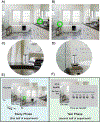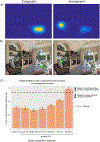Episodic memory processes modulate how schema knowledge is used in spatial memory decisions
- PMID: 35487103
- PMCID: PMC11179179
- DOI: 10.1016/j.cognition.2022.105111
Episodic memory processes modulate how schema knowledge is used in spatial memory decisions
Abstract
Schema knowledge can dramatically affect how we encode and retrieve memories. Current models propose that schema information is combined with episodic memory at retrieval to influence memory decisions, but it is not known how the strength or type of episodic memory (i.e., unconscious memory versus familiarity versus recollection) influences the extent to which schema information is incorporated into memory decisions. To address this question, we had participants search for target objects in semantically expected (i.e., congruent) locations or in unusual (i.e., incongruent) locations within scenes. In a subsequent test, participants indicated where in each scene the target had been located previously, then provided confidence-based recognition memory judgments that indexed recollection, familiarity strength, and unconscious memory for the scenes. In both an initial online study (n = 133) and replication (n = 59), target location recall was more accurate for targets that had been located in schema-congruent rather than incongruent locations; importantly, this effect was strongest for new scenes, decreased with unconscious memory, decreased further with familiarity strength, and was eliminated entirely for recollected scenes. Moreover, when participants recollected an incongruent scene but did not correctly remember the target location, they were still biased away from congruent regions-suggesting that detrimental schema bias was suppressed in the presence of recollection even when precise target location information was not remembered. The results indicate that episodic memory modulates how schemas are used: Schema knowledge contributes to spatial memory judgments primarily when episodic memory fails to provide precise information, and recollection can override schema bias completely.
Keywords: Memory; Recognition; Recollection; Schemas; Semantic knowledge; Visual search.
Copyright © 2022 Elsevier B.V. All rights reserved.
Figures




References
-
- Alba JW, & Hasher L. (1983). Is memory schematic? Psychological Bulletin, 93(2), 203–231. 10.1037/0033-2909.93.2.203 - DOI
-
- Anderson JR (1981). Effects of prior knowledge on memory for new information. Memory & Cognition, 9(3), 237–246. 10.3758/BF03196958 - DOI
-
- Bartlett FC, & Burt C. (1932). Remembering: a Study in Experimental and Social Psychology. British Journal of Educational Psychology, 3(2), 187–192. 10.1111/j.2044-8279.1933.tb02913.x - DOI

